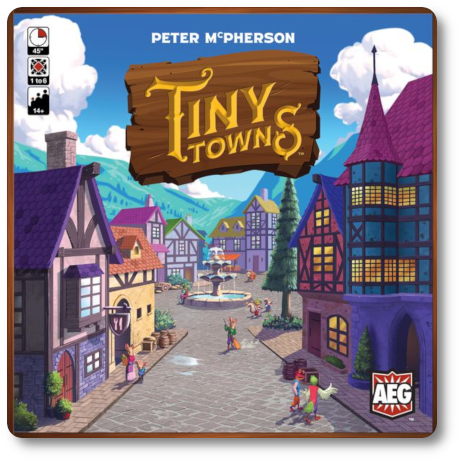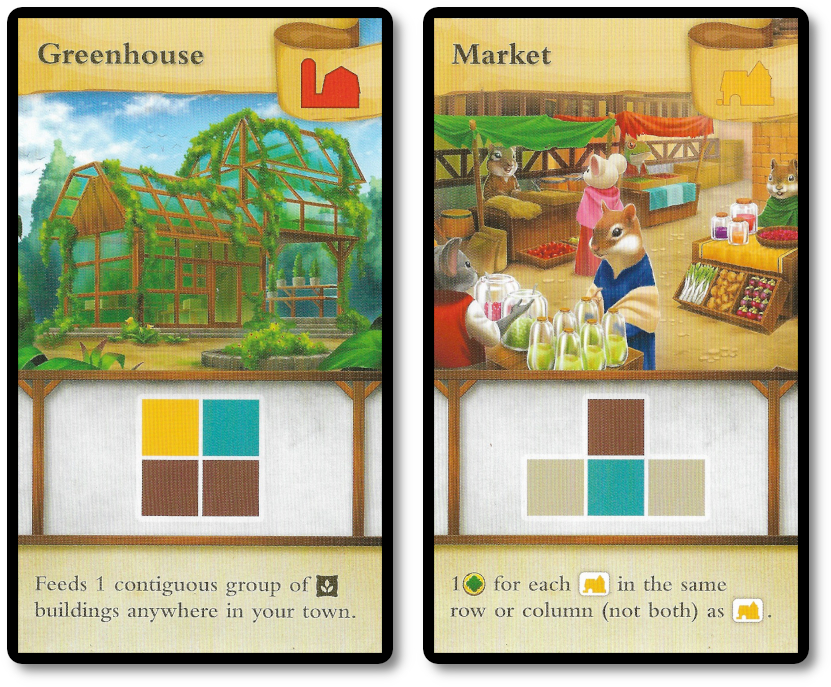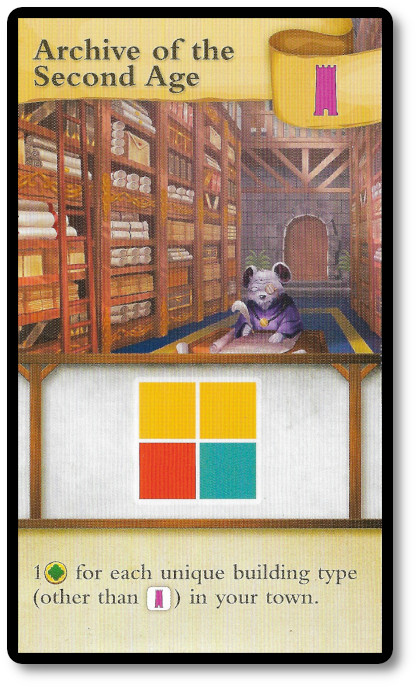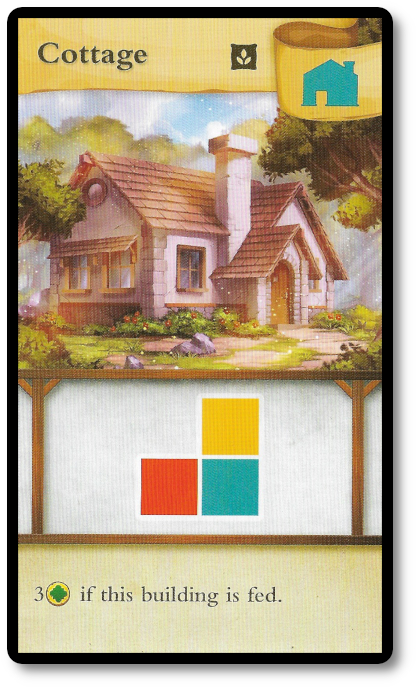
The Basics:
- For ages 10 and up (publisher suggests 14+)
- For 1 to 6 players
- Approximately 45 minutes to complete
Geek Skills:
- Active Listening & Communication
- Counting & Math
- Logical & Critical Decision Making
- Reading
- Pattern/Color Matching
- Strategy & Tactics
- Risk vs. Reward
- Visuospatial Skills
- Hand/Resource Management
Learning Curve:
- Child – Easy
- Adult – Easy
Theme & Narrative:
- Building a tiny town is no small task
Endorsements:
- Gamer Geek approved!
- Parent Geek approved!
- Child Geek approved!
Overview
Scottish Liberal Democrat politician and a Member of Parliament (MP) from 1983 to 2015, Charles Kennedy, said “Quality of life actually begins at home – it’s in your street, around your community.” In this game, players take on the role of building a tiny town for tiny animals. Careful planning is needed to ensure the community supports itself. Build too fast or build too big, and your tiny town will be a big bust.
Tiny Towns, designed by Peter McPherson and published by Alderac Entertainment Group, is comprised of six Player boards, 25 Building cards, 15 Monument cards, 15 Resource cards, one score pad, 126 wooden buildings, one wooden Master Builder hammer (first player) token, six wooden Monuments, and 90 wooden Resource cubes (in various colors). The cards are as thick and as durable as your standard playing cards. The boards are thick and durable, made out of cardboard. The wooden pieces range from various buildings/tools and typical small cubes. Excellent quality throughout.
Game Set Up
To set up the game, first give each player a Player board. Place any that are not used back in the game box.
Second, find and place the “Cottage” Building card in the middle of the playing area, face-up.
Third, sort the remaining Building cards into separate piles by their building icons. Each pile should have four cards each.
Fourth, shuffle the piles separately and draw one card at random from each, placing it face-up next to the “Cottage” Building card in a row. Return the unused Building cards back to the game box.
Fifth, shuffle Monument cards and deal two to each player, face-down. Players should look at the cards and select one to keep, placing it face-down in front of them. Return the unused Monument cards back to the game box without looking at them. Give each player one wooden Monument at this time that they should keep to one side of their Player board.
Sixth, organize the Resource cubes into pools by color. This is the Resource pool for the duration of the game. The Resource pools should be visible to all players.
That’s it for game set up. Determine who will be the first player and give them the wooden Master Builder hammer. Let’s get building!
Can We Build It?
Tiny Towns is played in rounds with no set number of rounds per game. All players participate in the round at the same time, with the player currently holding the Master Builder hammer leading the charge. A round of gameplay is summarized here.
Step One: Name a Resource
The player currently holding the Master Builder hammer reviews their Player board and calls out a Resource color for the round. The Resource cubes represent wood, wheat, brick, glass, and stone. While interesting to the narrative and theme, all players really need to pay attention to is the Resource color. As such, the player selecting the resource for the round should just say the color so as to not to confuse anyone.
Step Two: Collect Named Resource
Each player now collects one Resource cube of the color named by the player who is currently holding the Master Builder hammer. Once collected, the player must place the Resource cube to their player board.
This is where things get interesting…
Each of the Building cards (including the player’s Monument card) shows a pattern with specific colored Resource cubes. This pattern is what the players need to duplicate on their Player board with the collected Resource cubes if they want to build the building represented on the Building card. Once the Resource cube is placed in an empty space on the Player board, where it will remain until it’s removed during the current or subsequent rounds.

Step Three: Construct Buildings
If any player has successfully completed a pattern on their Player board that matches a face-up Building card or their face-down Monument card, they now announce it. This can be done in any order and any player can start it. If the player is building from a face-up Building card, they need only point to the card they are using. If the player is building their monument, they must reveal their Monument card at this time.
To complete a build, the player must demonstrate to their opponents that they have successfully created the required pattern on their Player board. The layout on the Player board can either directly match, be flipped, mirrored, and even rotated as long as the configuration and colors noted on the card remain similar to what is shown on the card.
If the player has successfully demonstrated that they have placed their Resource cubes in a correct configuration, they take a wooden building that matches the color and shape noted on the Building card and places it to their Player board. The location of the wooden building must be in one of the spaces currently occupied by one of the Resource cubes used to build. Once placed, all the Resource cubes used for the build are removed from the Player board and returned to the Resource pool.
If the player built their monument, they use their “Monument” wooden building and place it as noted above. Their Monument card remains face-up for the duration of the game. Each Monument card has a special ability and scoring rules. Players should keep track of these when their monument is successfully built.

Like Resource cubes, only one wooden building can occupy a space on the Player board. Unlike Resource cubes that can be removed when used to build, wooden buildings permanently stay on the Player board until the end of the game.
Step Four: Pass the Hammer
After all players have had a chance to build, the round ends. The Master Builder hammer is passed to the next player in the turn order sequence. A new round now begins starting with step one noted above.
Yes, We Can Build It! Sort of!
As the game progresses, players will place Resource cubes to create patterns that are then removed to build wooden buildings and their monument (which is always optional). Inevitably, a player will be knocked out of the gameplay, but not the game. This happens when a player no longer has room to collect Resource cubes on their Player board. Remember, once placed, Resource cubes remain until removed and replaced by a wooden building. Wooden buildings are never removed once placed. The player, once their Player board is filled (and essentially “locked”), remains at the table but no longer can participate in the rounds. This includes taking on the role of Master Builder. Sit back and relax.
Once all the players have locked their Player board, the game ends. Players now review their Player board and calculate their score. This is done by looking at the scoring details noted on the Building cards. Each building type scores points differently. For example, a “Cottage” must be fed. This is done by building a “Farm” which feeds up to four “Cottages”. If the player can feed their town, they score three victory points for each of the four “Cottages” fed by the “Farm” for a possible total of 12 victory points!

How many points a player earns is based on their ability to build patterns on top of patterns. Each of the buildings required a specific pattern to be placed. To be scored, the player’s buildings need to be in certain configurations on their Player board or have a certain number.
Included with the game is a score pad. Use it. This helps all the players keep track of their points in a very clear and clean way. Scoring can be confusing at first, but with the help of the score pad, it’s a simple enough exercise to review each of the Player boards in turn to calculate points. The player with the most points wins the game. It’s possible to have a negative score. In which case, the player with the highest score still wins, even if all the players have points below zero.
Game Variants
If playing with new, young, or inexperienced players, it’s suggested that your first game use the “Caverns” game variant. This allows players to place up to two Resource cubes that they must collect during the course of the game off to one side of their game board. And there they will remain, without causing any point penalties. However, once placed, the player is unable to access those Resource cubes. This gives players the flexibility to use or not use a Resource cube during each of the rounds, but only up to two during the game.
The “Town Hall” game variant uses the Resource deck, which is used by one player in the game who is assigned the title of “Mayor”. The “Mayor” will draw a Resource card at random for the first and second round. All players collect the noted resource. During the third round, players can select any resource they like. This pattern is repeated in the fourth, fifth, sixth, and all subsequent rounds thereafter. No other changes to the gameplay.
Tiny Towns can be played as a solitaire game. Resource cards are used to identify which Resource cubes can be selected. When the player can no longer build, they tally their points. Based on the points earned, they are given an achievement title. For example, scoring nine or fewer points gives the player the title of “Aspiring Architect”, but a score of 38 or more awards the player with the lofty title of “Master Architect”!
To learn more about Tiny Towns, visit the game’s web page.
Final Word
 The Child Geeks were not initially enjoying the game. The learning curve, while noted as “easy”, does not properly define the level of complexity that comes from playing the game. You can teach the game in a few minutes. Playing it well takes several tries. To quote one Child Geek, “Easy game to learn. Get resources and place them in a pattern. What is hard is keeping your town organized.” Another Child Geek said, “You have to watch where you build and keep track of your empty spaces. Your town fills up fast!” Indeed it does! Most Child Geeks had that “ah-ha!” moment halfway through the game and requested a quick restart. When all the towns were built, the Child Geeks unanimously voted to approve this abstract game of building the perfect little self-sustaining community.
The Child Geeks were not initially enjoying the game. The learning curve, while noted as “easy”, does not properly define the level of complexity that comes from playing the game. You can teach the game in a few minutes. Playing it well takes several tries. To quote one Child Geek, “Easy game to learn. Get resources and place them in a pattern. What is hard is keeping your town organized.” Another Child Geek said, “You have to watch where you build and keep track of your empty spaces. Your town fills up fast!” Indeed it does! Most Child Geeks had that “ah-ha!” moment halfway through the game and requested a quick restart. When all the towns were built, the Child Geeks unanimously voted to approve this abstract game of building the perfect little self-sustaining community.
 The Parent Geeks liked the game right from the start. According to one Parent Geek, “I like everything about this. From the initial way you have to plan your town, the patterns you have to create, and the management of space. Really neat little game that throws a lot at you without feeling overly difficult or burdensome.” Another Parent Geek said, “An abstract puzzle with a good mix of reactionary thinking and planning. Good game for the family and with my friends when they come over.” When all the votes were in, it was clear the Tiny Towns was a big hit with the Parent Geeks.
The Parent Geeks liked the game right from the start. According to one Parent Geek, “I like everything about this. From the initial way you have to plan your town, the patterns you have to create, and the management of space. Really neat little game that throws a lot at you without feeling overly difficult or burdensome.” Another Parent Geek said, “An abstract puzzle with a good mix of reactionary thinking and planning. Good game for the family and with my friends when they come over.” When all the votes were in, it was clear the Tiny Towns was a big hit with the Parent Geeks.
 The Gamer Geeks enjoyed the game but wanted there to be more player interaction. According to one Gamer Geek, “This is a game you play socially but is really just a solo game. You don’t compete for resources or space. Instead, players are just working together at different puzzles.” Which, as negative as the Gamer Geek’s comment might sound, worked well. As one Gamer Geek put it, “Despite the fact that I could be playing this all by myself, I liked that there was an element of competition that was based around best builds rather than better players. I was aware of the other players in the game, but I didn’t pay much attention to them. I was completely absorbed in my own town, making it the best way possible.” When all the votes were in, the Gamer Geeks all agreed that the game was entertaining and worth their time, finding it to be light and engaging.
The Gamer Geeks enjoyed the game but wanted there to be more player interaction. According to one Gamer Geek, “This is a game you play socially but is really just a solo game. You don’t compete for resources or space. Instead, players are just working together at different puzzles.” Which, as negative as the Gamer Geek’s comment might sound, worked well. As one Gamer Geek put it, “Despite the fact that I could be playing this all by myself, I liked that there was an element of competition that was based around best builds rather than better players. I was aware of the other players in the game, but I didn’t pay much attention to them. I was completely absorbed in my own town, making it the best way possible.” When all the votes were in, the Gamer Geeks all agreed that the game was entertaining and worth their time, finding it to be light and engaging.
 I rather enjoyed Tiny Towns. It takes up very little space and requires players to think big while working with well-defined limitations. So well defined, in fact, that the small board players received during game set up seem a bit daunting at first. It doesn’t take any longer than a few plays until you start to realize that space is limited, making each choice important.
I rather enjoyed Tiny Towns. It takes up very little space and requires players to think big while working with well-defined limitations. So well defined, in fact, that the small board players received during game set up seem a bit daunting at first. It doesn’t take any longer than a few plays until you start to realize that space is limited, making each choice important.
And here is where I had a bit of difficulty with the game…
Resources in the game are collected based on what the players call for. Because this is done on a turn-by-turn basis, players will always have an opportunity to collect the resource they want in order to follow their strategy and tactics. The majority of the game, however, the player has no say in what is collected and must make do with what is called. I found this, at first, to be very annoying. All I want to do is build a well-organized town! Instead, I find myself collecting a lot of resources for buildings I don’t want or need.
But hold up.
This was my “ah-ha!” moment in the game. When I realized that Tiny Towns is not about what you want to build but about how you make do with what you have. Players have to be flexible and see the “big picture” while navigating a constantly changing stream of available resources to build with. This was an interesting challenge, as the trick to the game is an entertaining mix of short and long term gains.
Which is damn tricky to juggle. Because a resource placed in the game occupies a space until it’s removed per build, players will start to lock their available spaces. By the very nature of the game, space is limited and quickly goes away. Players must navigate a strange mix of abundant resources via a small window of opportunity to use them. It creates excellent moments of pure frustration and exaltation.
Do try this small abstract game with big gameplay. It will challenge you to think of how best to leverage your limitations and find creative solutions. Great stuff and one I think you’ll enjoy.
This game was given to Father Geek as a review copy. Father Geek was not paid, bribed, wined, dined, or threatened in vain hopes of influencing this review. Such is the statuesque and legendary integrity of Father Geek.
Discover more from Father Geek
Subscribe to get the latest posts sent to your email.





